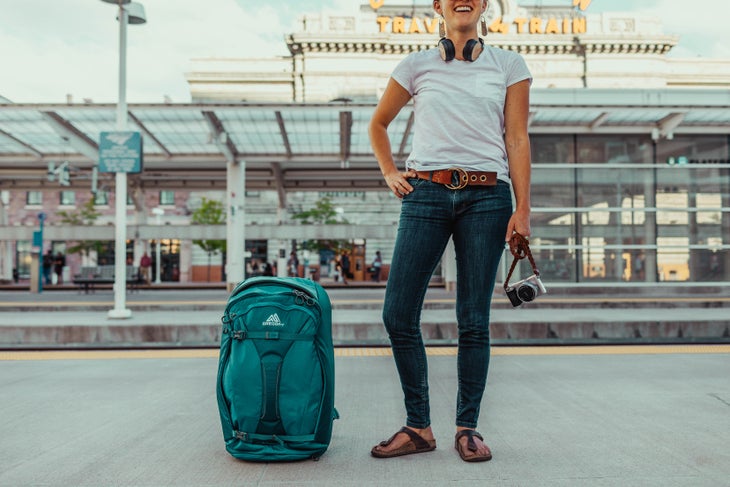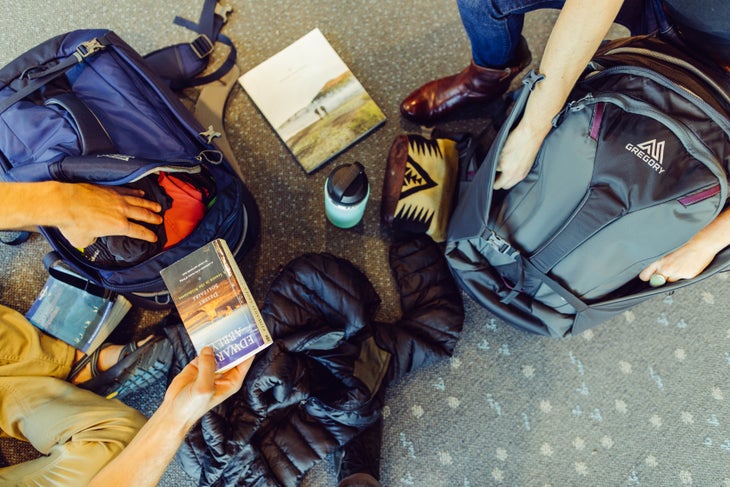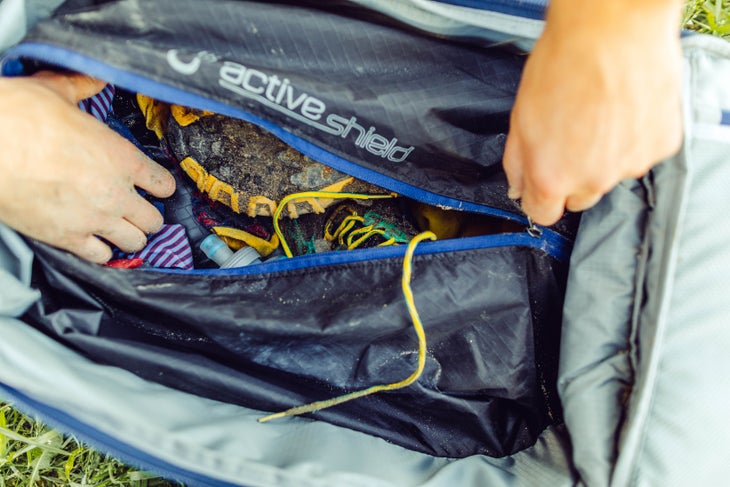How to Pack for Adventure Travel
The two great sins of packing are overdoing it and leaving important stuff behind. Follow these tips to make sure you and all the essentials get where you’re going.
Share this
Join Backpacker
Create a personalized feed and bookmark your favorites.
Already have an account?
Join Backpacker
Create a personalized feed and bookmark your favorites.
Already have an account?
Get full access to Outside Learn, our online education hub featuring in-depth fitness, nutrition, and adventure courses and more than 2,000 instructional videos when you sign up for Outside+ >”,”name”:”in-content-cta”,”type”:”link”>>’>Sign up for Outside+ today.
In the past 18 months, I’ve boarded airplanes more than 30 times in a dozen countries. Each time, I’ve gotten a bit better at packing and a bit less likely to forget things that make traveling easier. Here are my suggestions for stress-free packing for your next adventure.
Choose the best luggage
Choosing the right luggage is sometimes the hardest part of packing. It’s important to be nimble while navigating crowds and narrow alleyways, but bringing a pack that’s too small can create other challenges. If everything only just fits in your pack, you may end up wasting a lot of time repacking when you move hotels.
A wheeled suitcase, a duffel, and a backpack all have pros and cons. When I’m deciding which type to bring, I consider how often and for how long I’ll need to carry my luggage. I also think about the weather forecast and whether I’d be dragging a suitcase over cobblestones or need to climb a lot of stairs. Lately, my go-to bags have been a Gregory Proxy 65 backpack and a small tote or waterproof duffel. I’d much rather wear my luggage than carry it by the handles. Plus, the straps are all removable and tuck away to protect them from damage when it’s checked. This pack also has a huge capacity and tons of internal and external pockets so I know where everything is and can store my dirty clothes separately from the clean ones.

The Gregory Proxy keeps clean clothing and wet or dirty gear divided with its water-resistant ActiveShield compartment, and your laptop, business materials, and travel accessories in place with multiple pockets.
If you’re shopping for new luggage, take time to examine each option and the purpose each pocket can serve. I live out of a suitcase more often than not these days, so I’m willing to carry a bit of extra weight to feel organized. You may be the opposite, and a lighter-weight, less fully-featured bag may be the best route for you.
Make a list
I usually start a packing list a couple of weeks before I leave for a trip. Not only does it give me time to find the right clothes for the weather and activities of my trip, I also have plenty of time to remember the random things that are easy to forget when packing last-minute. Part of my process involves Googling “packing list [city I’m going to]” for oddball suggestions. When I went to Mexico City, one site suggested bringing a GRAYL water filter to avoid single-use plastic bottles. I hadn’t even thought about planning for water until I read that list.
Starting early is especially helpful for remembering the little things. I always make sure to bring a sleep mask and a natural sleep aid like melatonin and/or Sleepytime Tea when I take a long-haul flight. Headphones are easy to forget and expensive to replace. I also research currency exchange rates and most common forms of payment before leaving. In many countries, you can use a credit card for everything. In others, cash is king. Either way, be sure to have a debit card with you—put it on the list. In my experience, it’s always cheaper to get cash from an ATM than to exchange U.S. dollars a kiosk at the airport.
Get organized

Utilizing all pockets makes accessing your items you need easier during travel.
Once I start packing, I find it helpful to organize everything I want to bring before I start arranging it in my pack. It’s much easier when I can see everything together to identify what’s missing and what’s not needed. I stack clothes in folded, organized piles by type – pants, shirts, socks, etc. Once I have my piles, I Kon-Mari them: Do I need three pairs of hiking pants? Can I get by with one pair of jeans? Every article of clothing I can do without is one less thing to carry. It’s also one more space for something I want to bring home. Making a game out of reducing your luggage can be helpful. Try challenging yourself to nix three things from your piles. Challenge yourself to dump one more before you leave for the airport.
Pack smart
Packing cubes serve two purposes: First, they keep your stuff accessible. On a recent trip to camp in the Swedish Arctic, my slippers and sleep layers went in the same packing cube. This way, I avoided digging through my backpack in the snow to find warm clothes. Second, packing cubes can help compress your clothing so you have more space. Rolling your items can help save space and make it easier to identify what’s what. It takes more time to go through a stack of flat-folded items. Toward the end of your trip, they can also help you keep smelly clothes away from clean ones. I always make sure to have a small stuff sack for dirty socks and underwear.
To cut down on weight, pack clothing that repels odors and dries fast so you can wash it in your hotel room sink. You can get away with two or three pairs both of socks and quick-drying underwear regardless of the length of your trip if you wash them often.

The Gregory Praxus and Proxy backpacks keep clean clothing and wet or dirty gear divided with their water-resistant ActiveShield compartments.
Follow these tips and you’re more likely to come home with a story of the time you danced in the street with Parisian teenagers rather than when you missed your train because lugging bags slowed you down.
How to Pack for Adventure Travel
Pack light, pack smart, and always give yourself some breathing room.
A lot of my travel these days involves a long road trip, which has pros and cons in the packing department. On the one hand, it’s super easy to throw all the clothes and gear I might want during my trip into my truck without worrying about fees for checking extra bags or the other added hassles of flying with lots of luggage. However, this means I have to seriously switch gears when packing for a trip if I’m flying. Every trip is different of course, but I’ve learned a few lessons that have helped me kick my road trip packing habits when I’m getting ready to fly for an adventure.
1. Less Is More
When you’re traveling by plane, it’s always a good idea to save weight and space wherever you can. One way to do this is to pack items that can satisfy multiple use cases, like a single pair of boots that can work just as well hiking and camping, walking through a museum, or for a night on the town. I also like to keep my clothing options simple; pack a few t-shirts, an extra pair of pants, and a button down. Don’t bring a fresh outfit for each day (except maybe socks and underwear), plan to wear shirts a couple times and do laundry on the go if need be.
2. Pick the Right Pack
This is largely dependent on the type of trip you’re planning. If you’re planning to be on the move daily, covering a lot of ground by foot (like a backpacking trip through Europe), you’ll want a large backpacking pack with a supportive frame. For air travel and day trips around your destination, a duffel pack like Eagle Creek’s Migrate Duffel is a simple and surprisingly roomy solution and a go-to for our Explorer Jon Mattrisch (see his full review here).
3. Systems
Having your items organized in a systematic way can be a game-changer, especially for long-term trips. I like to use spare fabric bags (like from a climbing or biking helmet) to organize items by category within my pack but if you want to step up your game, try the ultra-light packing cubes from Eagle Creek. This also comes in handy to keep dirty clothing separate from clean clothes. Without a system like this, my pack quickly becomes a jumbled mess.
4. Rent and Borrow What You Can
If you’re traveling for an activity-heavy trip like climbing in Thailand or surfing in Nicaragua, find out what options you have for renting or borrowing gear when you get there. Say you’re on a ski trip to Banff and you’re flying from San Francisco, for example. Look into options to rent skis, boots, and poles at or near the resort and see if it’s more cost effective to rent gear vs. paying for the extra checked luggage. Or if you’re flying in for a mountain biking trip to Ventura to visit an old friend, see if she has access to a helmet and bike shoes you can borrow so you can save space in your pack.
5. Leave Room for Flexibility
Pack light, pack smart, and always give yourself some breathing room. You may come across a killer deal on a piece of gear or a souvenir from your trip that you just can’t pass up. If the friend you’re visiting has a jacket that he doesn’t use that happens to be just what you’re looking for, you don’t want to pass it up because you don’t have space in your bag.
We want to acknowledge and thank the past, present, and future generations of all Native Nations and Indigenous Peoples whose ancestral lands we travel, explore, and play on. Always practice Leave No Trace ethics on your adventures and follow local regulations. Please explore responsibly!
Do you love the outdoors?
Yep, us too. That’s why we send you the best local adventures, stories, and expert advice, right to your inbox.
Adventure Travel: 15 Must-Know Packing Tips
Perfect packing is possible, and we made a list for it. Check these off before gearing up for a faraway trip this year.

Here at GearJunkie, travel is an integral part of what we do. We culled these 15 packing tips from our experiences on the road, including mistakes we made over the years traveling to the Rocky Mountains or as far as Kathmandu.
15 Packing Tips for Travelers
1. Make a Master List
A few days before a trip, begin a list on paper or your phone. Write down items that are needed and obscure: passport, maps, sunglasses, hat, lip balm, water bottle, a book for the plane, etc. Keep the running list close at hand and add to it as things pop into your head. Keep it saved on your phone (or written on paper) for your next trip, and you’ll be ahead of the game.
2. Personal Documents & ID
Print out all important documents for a trip, including hotel reservations, rental car info, directions, and any contacts. (Don’t rely solely on digital copies on a phone.) Make a photocopy of your passport and store it in a different part of your luggage than your real passport; in a worst-case scenario, you’ll have a backup.
3. Wallet/Purse Dump & Scan
Before you leave, take all credit and ID cards from your wallet or purse, lay them on a table, and take a photo. Shoot the front and back of all the cards and IDs. You’ll then have a backup digital record in case your wallet goes missing on the road.
4. Pack Less
Overpacking clothes is a top violation of adventure travel. Before you start shoving everything into your bag, ask, “Do I really need three pairs of jeans?” Many travelers wear the same clothes multiple days in a row (we sure do), which significantly cuts down on pack/luggage weight and the hassle of managing a wardrobe on your trip.

5. Multi-Day Apparel
Avoid cotton, since it’s mostly wearable one or two days before needing a wash. We often bring shirts made of merino wool, as they’re wearable multiple days in a row and work across a range of temps. Another option is clothing treated with Polygeine, which doesn’t need to be washed as often.
6. Adventure Gear
A night hike, river tubing, or secret singletrack – you never know what adventure may arise while traveling. Don’t miss out because you don’t have the gear. Below are gear staples for us on any adventure:
- Rain jacket
- Daypack
- Headlamp
- Water bottle
- Compass
- Swimsuit
- Dry bag (waterproof)
- Bandana or Buff headwear
7. Backpack or Luggage?
Rolling luggage is de rigueur for air travelers. But if you’re hopping off an airplane to walk, bike, trek, or explore, then wheeled luggage quickly becomes a hassle. Use backpacks instead, including made-for-travel packs like the Eagle Creek Global Companion (photo above).
8. Breakables in Carry-On
Computers, cameras, and any breakables should not be packed in luggage going into the belly of the plane. Keep those items in the above-seat bin on a plane or in a pack stuffed under the seat so you can protect them on the go.
9. Check the Weather
Rainy days can ruin trips. Make the most out of each day by packing the right clothing, rain jackets included. Especially in the desert or high country, check the forecast to make sure you are covered.
10. Airplane Apparel
Long flights are requisite for many trips. Think ahead and dress for the occasion. Wear comfortable clothing and include layers to strip off or add, as the temperature in many planes is unpredictable from hot to cold. Also consider a hat, earplugs, eye mask, and a neck pillow on flights longer than a couple hours, where you can sleep.
11. Pack a Snack
Bringing food from home lets you avoid paying ridiculously high prices at the airport for processed junk. Be the envy of the aircraft with fresh food from home. When everyone else eats airline peanuts, pull out a fresh box of blueberries.

12. Buy a Phone
Most data plans don’t work or charge expensively when traveling internationally. Instead, buy a pre-paid SIM card or cheap phone at your destination. With a phone, you can worry less about losing your travel partner, use GPS, post photos and travel updates, and call for Uber or Lyft rides in cities.
13. Leave Room for Souvenirs
Will you have time to visit a gift shop or local market? If you’re a gift-giver, pack an empty, lightweight bag or pack within your luggage. Use this extra pack or bag if you can’t fit everything on the way home.
14. Compartmentalize
Odor from dirty clothes and shoes can seep into your clean clothes and have you spending time at a laundromat instead of adventuring. Use a product like a Shoe Sac, or even a plastic bag, to keep the clean separate from the dirty. Storing them in a separate bag or compartment of your pack is a simple hack to mitigate the funk.

Some travel-specific gear comes with an integrated rain jacket pocket or shoe container. Eagle Creek’s Global Companion 40 has two zippered storage pockets to separate the dirty from the clean.
15. Tiny Toiletries
Travel-size toiletries are sold at most drugstores or groceries. Stock up on 3-ounce (or smaller) shampoo, soap, toothpaste, deodorant, and other needed personal items. The made-for-travel sizes will pass through airline security and offer enough quantity to service a traveler for a week or more on the road.
–This article is sponsored by Eagle Creek. Check out the brand’s travel pack – the Global Companion 40L – to help perfect your packing.
Source https://www.backpacker.com/skills/how-to-pack-for-adventure-travel-gregory/
Source https://www.theoutbound.com/liam-mcnally/how-to-pack-for-adventure-travel
Source https://gearjunkie.com/travel/packing-tips-adventure-travel